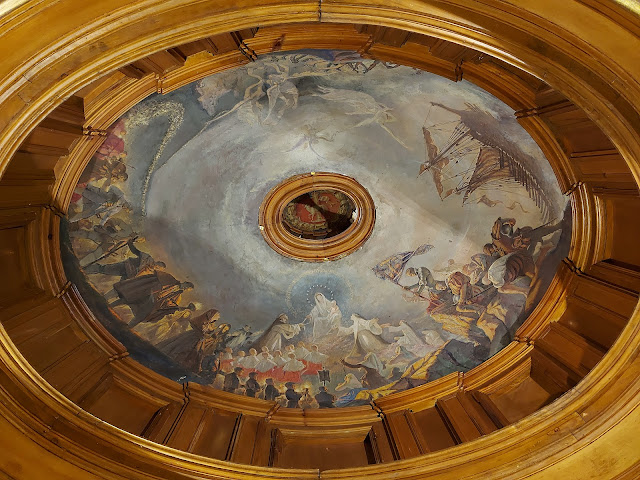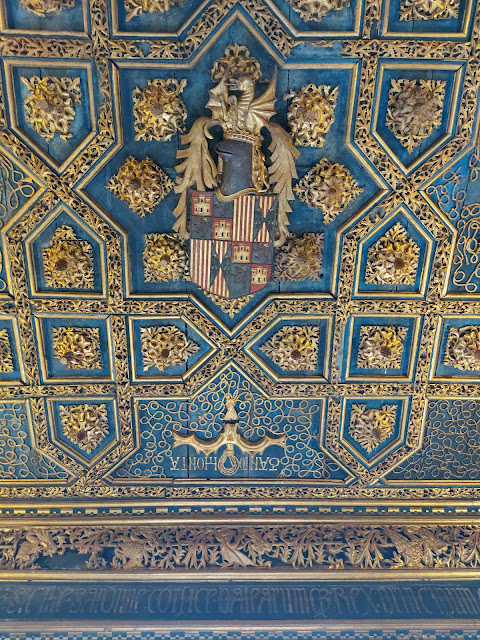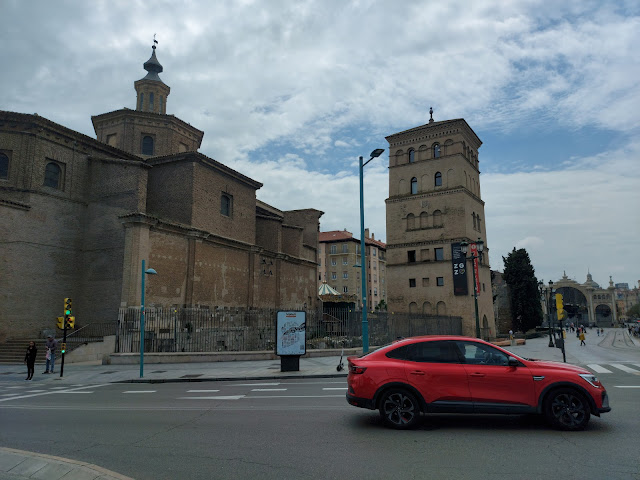 |
| Zaragoza was the capital of the Kingdom of Aragon. |
 |
| A monument to Zaragoza's two stout defenses against the French in the Peninsular War. |
 |
| A relief of the coats of arms of the Kingdom of Aragon from the 15th century in the Zaragoza Museum. |
 |
| A Roman mosaic of Eros and Pan from the 2nd century A.D. |
 |
| Orpheus taming the beasts |
 |
| Symbols from a 4th century agricultural calendar |
 |
| A recreation of a Roman home in Zaragoza |
 |
| Celt-Iberian helmets from the 3rd century B.C. |
 |
| The coffin of a 15th century Countess of Barcelona |
 |
| Jesus saves! |
 |
| The 14th century tomb of a bastard of King James 1 the Conqueror. |
 |
| A 16th century altarpiece with the coats of arms of Aragon on it |
 |
| Goya was a strange man |
 |
| Very strange |
 |
| This is not by Goya, but probably inspired by him. |
 |
| One should not be surprised that Zaragoza has amazing tapas. Meli Del Tubo is a great place to try some. |
 |
| Don't forget dessert! |
 |
| The Cathedral-Basilica of Our Lady of the Pillar is at the heart of the city. |
 |
| The cathedral claims to be the first to be dedicated to the Virgin Mary. |
 |
| There is a large plaza in front of the cathedral. |
 |
| The current version of the cathedral was built in the 17-19th centuries. |
 |
| Our Lady of the Pillar is the version of Mary that appeared to Saint James when he was having trouble converting people in Spain. |
 |
| The Hispanic Fountain |
 |
| The church next to our hotel |
 |
| The Zaragoza Argonath? |
 |
| A memorial to Francisco Goya, who was from Zaragoza. |
 |
| The Cathedral of the Savior of Zaragoza, or La Seo, is the other major cathedral in Zaragoza. |
 |
| It was originally a mosque. |
 |
| When Alfonso the Battler took over Zaragoza in 1118, he did not destroy the building, but gave the Muslims one year to leave town. |
 |
| The ceiling of another church |
 |
| Zaragoza is famous for the Fiesta del Pilar and its glass floats. |
 |
| The Alcazar |
 |
| Cathedral of Our Lady of the Pillar |
 |
| An unfortunate Dominguito del Val float, a child who was the subject of an anti-Semitic blood libel story |
 |
| Zaragoza was originally inhabited by an Iberian tribe, but later heavily developed by the Romans. |
 |
| Aljaferia Palace was built by the Taifa of Zaragoza in the 11th century. |
 |
| The palace requires online reservations at least a day in advance to visit. |
 |
| It is one of the most important examples of Spanish Islamic architecture after the Mosque-Cathedral in Cordoba and the Alhambra. |
 |
| The castle served as the residence of the Kings of Aragon until the crowns merged in 1492. |
 |
| The regional parliament now calls the castle home. |
 |
| The president of the Cortes of Aragon gets a pretty cool portrait background. |
 |
| Zaragoza was called Salude or Salduba before Roman times. The Arabs used this name and called is Saraqusta, from which Zaragoza was derived. |
 |
| Romans ruled the city as Caesaraugusta from just before Christ until the 5th century, when it was taken over by Goths. |
 |
| The Umayyads conquered the city in the 8th century. |
 |
| The Caliphate of Cordoba collapsed in the 10th century, and Zaragoza became the capital of its own taifa, or state. |
 |
| Its hard not to order churros and chocolate in every city in Spain. |
 |
| A big Caesar |
 |
| More tapas! |
 |
| The remains of the Roman forum are under La Seo. |
 |
| A depiction of a local 4th century Christian martyr in the Alma Mater Museum. |
 |
| An old Islamic map in the |
 |
| Roman ruins are everywhere under the city. |
 |
| The Goya Museum has an extensive collection. |
 |
| His prints are the best. |
 |
| Bravissimo! |
 |
| This guy is such a donkey, his family tree is full of donkeys. |
 |
| Zaragoza is one of Spain's great cities! |





